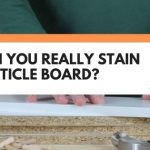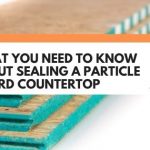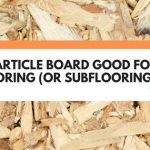Particle board is one of the more widely used manufactured woods around. Similarly to MDF and Plywood, this material is a wood composite, made up of natural wood byproduct and glue.
On one hand, this makes Particle Board (also known as Chipboard), much cheaper than solid natural wood. However, despite being budget-friendly, it is far from the most durable engineered wood you can use for a desk.
So, in this post, we dive into what really goes into the manufacture of particleboard. We also explain why particleboard isn’t the best material choice if you happen to live in a humid area.
And keep reading to discover the main (and pretty much only) reason to choose particleboard for your next desk.

This post may contain affiliate links to products that we receive a commission for (at no additional cost to you). Learn more here.
What Is A Good Wood Material Choice For A Home Desk?
The more durable the wood, the better.
So solid natural wood desks, made from tough hardwoods such as Oak, are ideal options.
What About Affordability? What Are Cheap Desks Made Of?
The most affordable desks are made from manufactured woods. So, low-cost desks are made with MDF (Medium Density Fiberboard), or Particle Board (also known as Chipboard).
And desks made from these types of manufactured composite woods tend to have a melamine or laminate surface.
But Is Particle Board OK For A Home Desk?
It’s OK, not great, but just OK.
It isn’t as strong as MDF, OSB, or Plywood. But as long as you aren’t loading it with heavy equipment, Particleboard works fine as a desk.
Nonetheless, if you plan on putting stacks of heavy books on it, you may want to give Particleboard a miss.
So What Is Particle Board Best Suited For?
Honestly? It is best used as a way to save money.
Sure, you can find it being used for furniture, flooring underlayment, and cabinets.
But, it is more of a cost-cutting option, than a first choice material.
Why Is Particle Board Furniture Poor Quality? Does It Break Easily?
Compared to every other wood composite material you can use? Pretty much.
Many other manufactured woods are stronger in various different ways. OSB beats it in terms of shear strength. And plywood is stronger than particle board — in terms of compressional strength.
Now, when we’re talking about the strength of manufactured wood, there are three main things we look at: how well it handles being pulled apart, crushed, and slippage. Or, in more technical terms, its tensile strength, its compressional strength, and its shear strength.
For making something like a desk, what really matters most is how it stands up to compression – how much weight it can hold before it gives out and collapses. After all, that desk is going to be holding up your computer, books, papers, and anything else you pile on there day after day.
Now plywood, that stuff is crazy strong when it comes to compression. It can take up to 5,000 pounds per square inch (PSI) it can take before failing. Particleboard on the other hand, doesn’t quite stack up.
Mid-grade Particleboard maxes out around 2,100 PSI – still solid, but not as hardcore as plywood. More than enough to handle some textbooks and notebooks without buckling, but I wouldn’t try resting an elephant on it.
If you want to really geek out on the nitty gritty details of plywood vs particleboard strength, check out this post we did comparing the two here: Plywood Vs Chipboard: Which One Has The Strength To Make For Great Flooring?
Particleboard is also difficult to fasten too. You need to use special screws if you want them to stay securely inside this material.
Related Post: Does Particle Board Furniture Need Special Screws (Vs Regular Wood Screws)?
And there’s the little issue of water-damage.
Particle board is made up of waste-wood and glue. Get even a little moisture or humidity in it, and it will become unstable and swell up.
Plus, once it is water-damaged, fixing it is an incredibly difficult job. Especially once any rot starts to take hold as a result of damp.
What Happens If Particle Board Becomes Wet?
At best, it swells and throws off the dimensions of the desk. At worst, it stays damp, becomes difficult to dry-out, and starts to rot away and crumble.
Plus, it doesn’t take a lot of moisture for this super-sponge-like material to become water-damaged. And if you live in a climate that has a lot of high humidity, that Particle Board desk may not last.
But if you do, let me throw another option out there for you – OSB (oriented strand board).
If you live somewhere humid, high-grade OSB just might be a better choice than particleboard – or even plywood – for a desk. At least, if you are very determined to use manufactured wood for your desk.
We dig into more detail about using OSB boards in humid environments in this post here. Give it a looksie if you’re set on using a manufactured wood product but want something that can handle some moisture: Can OSB Board Really Get Wet? (7 Things You Need To Know)
Related Post: What You Need To Know About Sealing A Particle Board Countertop
And How Long Do Particleboard Desks Even Last For?
With only light usage, it can see out five years. Provided you carefully keep the desk away from moisture.
But, with regular everyday use, it will last half that time — roughly two to three years tops.
Does That Mean Particle Board Is A Bad Choice For A Desk?
It’s generally a poor choice for most any type of furniture.
However, it’s so cheap, you can easily replace a damaged particleboard desk, if it does fall apart.
So, if you want a short-term desk quickly — at a budget friendly price — go ahead and buy that particleboard desk. But, be prepared to replace it in a few years.
To Wrap Up, Here Are The 3 Key Takeaways From This Post…
- 1). Particleboard is also known by the name Chipboard. It is sometimes also referred to as Low Density Fiberboard.
- 2). Particle board is a manufactured wood, made up of compressed wood waste and glue.
- 3). Particle board isn’t as strong as other popular manufactured woods, such as OSB, MDF, or Plywood. However, it is one of the most affordable.
References:
Moisture and Thermal Epansion of Wood, Particle Board, and Paper | Ben-Gurion University Research Portal (bgu.ac.il)



